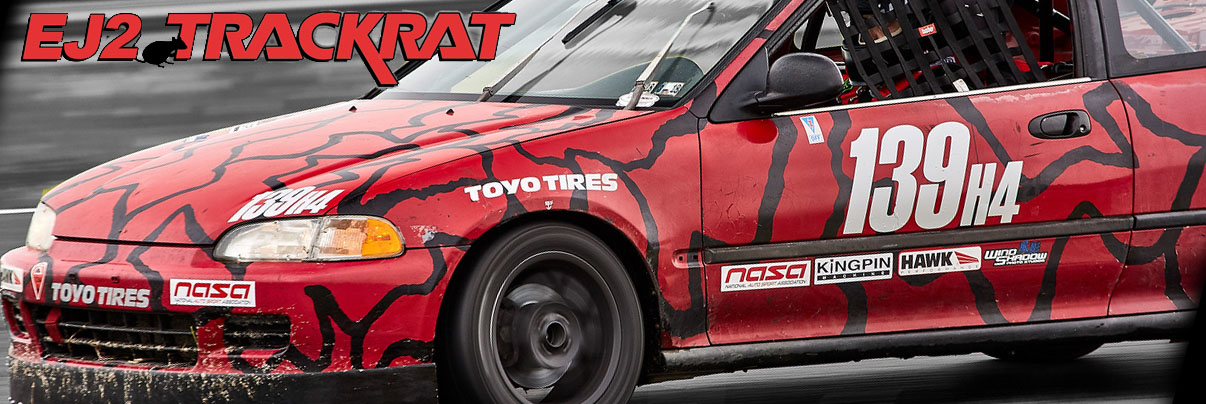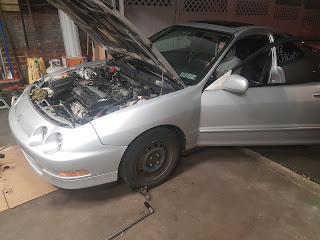Thunder at the Glen with NASA Northeast
9/28-9/30/18
Two weekends ago, I went to Watkins Glen International with the National Auto Sport Association (NASA) Northeast (NE) Region. It was their fourth race weekend of the season and my third race weekend ever, so I tried as best I could to apply the lessons learned from my first two race weekends to improve my car setup and driving style.

My journey started at 5:00 AM when I left my apartment near Philly for my job in Central Jersey. I had recently regreased the wheel bearings on my dolly for the first time ever and replaced the idler and tensioner pulley on my truck to try and remedy a noise that ended up being a water pump. With no time left, I decided I'd keep an eye on my mechanical troubles and trudge forward.
After the work day was complete. I conducted my four hour drive with my trusty steed and my speedy race car. Once at the track, I met up with my friend Anthony and another fellow Honda Challenge driver, Mike Fries, and we all chatted for a while before I set up camp inside of my truck.
Normally I sleep inside a tent, but by recommendation of my friend Alex, I tried the truck. And I have to say, sleeping inside a truck during the Fall at Watkins Glen is MUCH warmer than sleeping in a tent. If you get cold? You turn the heat on and let the truck run through the night.
The next morning, I got up, got in my car, put my NASA NE Volunteer shirt on, and I drove to the garage to help the NASA NE Volunteers with technical inspection.
With NASA NE, you have the option to volunteer and accumulate "credits" for track days. If you've been volunteering for some time and you get the swing of things relatively quickly, you can even volunteer and drive at the same time. You don't get credits in the latter case, but it's a great incentive to socialize and develop relationships with great people.
As a volunteer, you'll get to meet racers, learn driving skills, develop wrenching skills, and have a great time meeting new people. In the pic below you'll see my buddy Alex helping me record data in his NASA NE Volunteer shirt with my good friend TJ who is an instructor with NASA.
Below, you'll see my buddy Ben adjusting scales after a Thunder Group car (a really fast Corvette) came through to check their weight.

The test day went well and the car was well balanced at this fast and relatively loose track. Though I decided I would need to up my rear bar rate and increase my front spring rate in the long run. I learned that my top speed was about 113 MPH on the back straight at Watkins Glen at the time. Ken, the points leader in H4 wasn't there to shake his car down, but Damien was and he and I battled for a long time. His car was down about 7 MPH on the back straight compared to me due ot his aerodynamics having more drag. You'll see Damien's car below.

On Friday night, we enjoyed a track walk and a night out on the town. Mike Fries of Honda Challenge H2 shared his expertise with us, discussing the corners and their constantly changing camber angles. It served me and Damien greatly as we listened. Kallie and Ken, our competitors were either off elsewhere or on their way to the track due to life catching up with them beforehand.

Saturday was the first race day. It was a bright, sunny day, and our first practice and quali sessions resulted in providing the best conditions for me in the 139 car-- pumping out the fastest time of H4. I blacked out my competitors' last names and times for their own privacy.
However, as usual, Ken pulled a rabbit out of his hat and managed to FLY by the competition. With Spencer of Honda Challenge giving him LoBuk Motorsports Coaching, he really had some great knowledge backing him up.

I secured P2 by the skin of my teeth, getting lucky when an ST5 car wouldn't let my competition, Damien, by as I struggled with fuel starvation through corners and overheated tires. Below you'll see a picture of myself and then Damien and Kallie on track (silver Civic and dark silver Integra, respectively).

After Race 1, Ken, Dame, and I went to WalMart to get some beer, some fire wood, and a pumpkin that we put on top of Kallie's car while she was asleep. IT WAS HEAVY. They made me grab it from the bottom of the cardboard bin! You'll see a pic of Dame holding it.
The next morning we woke up and it was damp out. The radar said that it would be dry for the whole day, but it ended up raining throug practice/quali... I utilized the conditions to my advantage despite being scared and qualified first once more!
Given the results from the previous race and from previous race weekends, I was confident Ken would secure first, but what I thought would be a predictable race ended up being a tight race between me, Kallie, and Dame.
We all ended up finishing. There were a lot of incidents and two major full-course cautions accompanying those incidents. However, Ken, Damien, Kallie, and Myself were able to get through with no major issues. Kallie did give me a little love tap (my first race contact), but I was able to catch it in T1 and win the race!
In a way, I was lucky that there were so many incidents.
My driver side, 35-dollar axle from RockAuto ended up failing after one practice session and 2 or 3 laps on track. When I inspected it after the race, the heat damage was apparent...and very blue!
After the race, Anthony and I drove home together since we live so close and we got back safe.
It was a great weekend to be there and I am thankful for people like the Casellas who help organize events like this and to organizations like NASA that make it possible for amateur racers to have such a great time. Papa Joe Casella is shown policing the event (and his dog Axle) in the pic below.

Lastly, thank you all for reading! Until next time, keep following my Instagram account at @EJ2_TRACK_RAT and my Facebook Page.
Thanks all :)





















